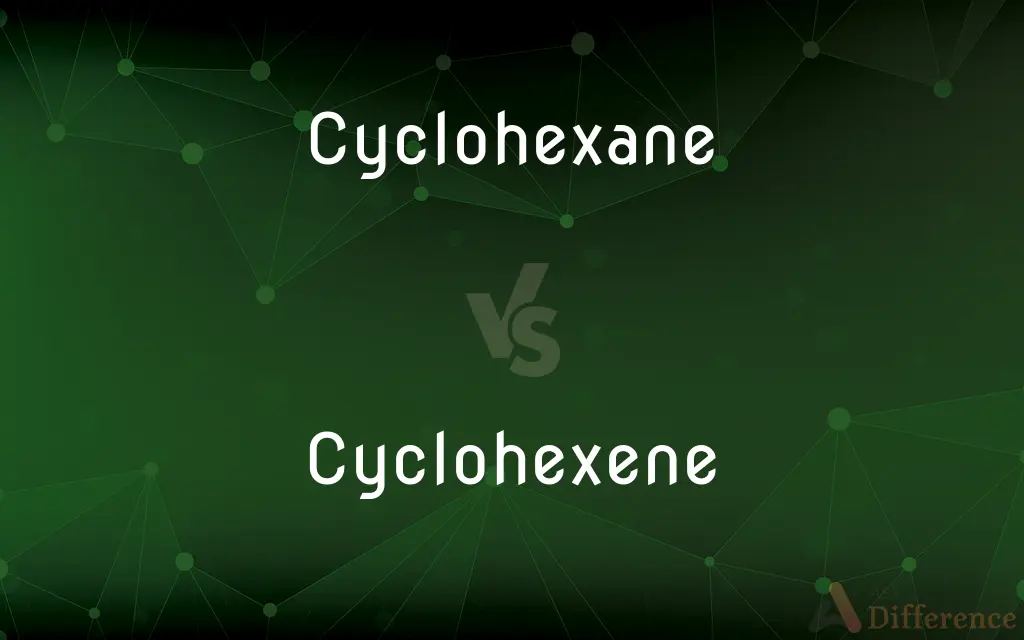Cyclohexane vs. Cyclohexene — What's the Difference?
By Tayyaba Rehman — Updated on September 28, 2023
Cyclohexane is a saturated hydrocarbon with a six-carbon ring structure, while cyclohexene is an unsaturated hydrocarbon with a double bond in its ring.

Difference Between Cyclohexane and Cyclohexene
Table of Contents
ADVERTISEMENT
Key Differences
Cyclohexane and Cyclohexene are hydrocarbons, both composed of carbon and hydrogen atoms, and they share a similar cyclic structure. Cyclohexane is a saturated hydrocarbon, meaning it has single bonds between the carbon atoms, forming a stable, ring-shaped molecule with the chemical formula C₆H₁₂. Cyclohexene, in contrast, is an unsaturated hydrocarbon, containing a carbon-carbon double bond within the six-carbon ring, resulting in the chemical formula C₆H₁₀.
The presence of a double bond in Cyclohexene means it is more reactive than Cyclohexane. This double bond introduces a point of unsaturation, making Cyclohexene susceptible to reactions that can break this bond, allowing the addition of new atoms or molecules, such as hydrogenation or halogenation reactions. On the other hand, Cyclohexane, with its single bonds, exhibits lower reactivity, and typically undergoes substitution reactions.
In terms of physical properties, Cyclohexane and Cyclohexene differ notably. Cyclohexane is relatively nonpolar and will not mix with polar solvents like water; it has a higher boiling point compared to Cyclohexene due to the increased number of hydrogen atoms. Cyclohexene, being unsaturated and containing a double bond, has a lower boiling point and can participate in reactions with polar molecules more readily than Cyclohexane.
When considering usage and applications, Cyclohexane is often used as a solvent in the laboratory and industrial settings, and as a starting material in the synthesis of various compounds due to its stability. Conversely, the reactivity of Cyclohexene makes it valuable in chemical synthesis as it can undergo a variety of chemical reactions to form diverse compounds, offering utility in the production of polymers, resins, and other chemicals.
In summary, while Cyclohexane is a saturated, stable hydrocarbon used extensively as a solvent and starting material, Cyclohexene is an unsaturated, more reactive hydrocarbon useful in chemical synthesis due to the presence of a carbon-carbon double bond.
ADVERTISEMENT
Comparison Chart
Chemical Formula
C₆H₁₂
C₆H₁₀
Bond Type
Single bonds (saturated)
Contains a double bond (unsaturated)
Reactivity
Lower reactivity due to saturated bonds.
Higher reactivity due to the presence of a double bond.
Boiling Point
Higher boiling point.
Lower boiling point.
Applications
Used as a solvent and starting material in synthesis.
Valuable in chemical synthesis of diverse compounds.
Compare with Definitions
Cyclohexane
A hydrocarbon that does not readily mix with polar solvents like water.
Due to its nonpolarity, Cyclohexane forms a separate layer when mixed with water.
Cyclohexene
A colorless liquid hydrocarbon containing a carbon-carbon double bond.
The presence of a double bond in Cyclohexene increases its reactivity.
Cyclohexane
A saturated hydrocarbon with a chemical formula of C₆H₁₂.
Cyclohexane is often used as a nonpolar solvent in laboratories.
Cyclohexene
An unsaturated hydrocarbon with a chemical formula of C₆H₁₀.
Cyclohexene is a useful intermediate in organic synthesis.
Cyclohexane
A stable, ring-shaped molecule composed of six carbon atoms connected by single bonds.
The single bonds in Cyclohexane contribute to its stability.
Cyclohexene
A compound that is more reactive than its saturated counterpart, Cyclohexane.
The double bond in Cyclohexene allows it to undergo addition reactions.
Cyclohexane
A colorless, flammable liquid with a sweet smell.
The technician filled a container with Cyclohexane.
Cyclohexene
A cyclic compound that can participate in reactions with polar molecules more readily than Cyclohexane.
Cyclohexene's reactivity with polar molecules is due to its point of unsaturation.
Cyclohexane
A compound used as a starting material in the synthesis of various chemicals.
Chemists often employ Cyclohexane in the synthesis of nylon.
Cyclohexene
A hydrocarbon used in the synthesis of polymers, resins, and other chemicals.
The chemical industry utilizes Cyclohexene in the production of various products.
Cyclohexane
Cyclohexane is a cycloalkane with the molecular formula C6H12. Cyclohexane is non-polar.
Cyclohexene
Cyclohexene is a hydrocarbon with the formula C6H10. This cycloalkene is a colorless liquid with a sharp smell.
Cyclohexane
A colourless flammable liquid cycloalkane obtained from petroleum or by hydrogenating benzene, and used as a solvent and paint remover.
Cyclohexene
(organic compound) A cyclic hydrocarbon containing six carbon atoms and one double bond; any of its derivatives.
Cyclohexane
A flammable, colorless, mobile liquid cycloalkane, C6H12, obtained from petroleum and benzene and used in the manufacture of nylon and as a solvent, a paint remover, and a varnish remover.
Cyclohexane
(organic compound) An alicyclic hydrocarbon, C6H12, consisting of a ring of six carbon atoms; a volatile liquid.
Common Curiosities
Can Cyclohexane mix with water?
No, Cyclohexane is relatively nonpolar and does not readily mix with polar solvents like water.
How does Cyclohexene differ from Cyclohexane?
Cyclohexene contains a carbon-carbon double bond, making it an unsaturated and more reactive hydrocarbon compared to the saturated Cyclohexane.
Is Cyclohexane flammable?
Yes, Cyclohexane is a flammable liquid with a sweet smell.
Why is Cyclohexene more reactive than Cyclohexane?
Cyclohexene is more reactive due to the presence of a carbon-carbon double bond, introducing a point of unsaturation.
What is the primary application of Cyclohexene?
Cyclohexene is primarily used in chemical synthesis, forming various compounds due to its reactivity and double bond.
What is Cyclohexane?
Cyclohexane is a saturated hydrocarbon with the chemical formula C₆H₁₂, often used as a solvent and starting material in synthesis.
Is Cyclohexane a stable compound?
Yes, Cyclohexane is stable due to its saturated, single-bonded carbon atoms forming a ring.
Can Cyclohexene undergo addition reactions?
Yes, the double bond in Cyclohexene allows it to undergo addition reactions, adding atoms or molecules at the point of unsaturation.
Share Your Discovery

Previous Comparison
Freak vs. Weird
Next Comparison
Define vs. CreateAuthor Spotlight
Written by
Tayyaba RehmanTayyaba Rehman is a distinguished writer, currently serving as a primary contributor to askdifference.com. As a researcher in semantics and etymology, Tayyaba's passion for the complexity of languages and their distinctions has found a perfect home on the platform. Tayyaba delves into the intricacies of language, distinguishing between commonly confused words and phrases, thereby providing clarity for readers worldwide.
















































